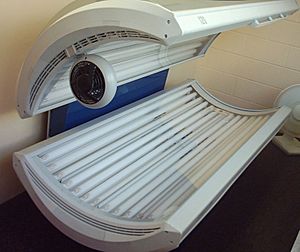Tanning bed facts for kids
A tanning bed is a special machine that uses ultraviolet (UV) light to make your skin look darker, like a tan you might get from the sun. Just like spending too much time in the sun, staying in a tanning bed for too long can give you a sunburn. There are different types of tanning beds, but most look similar to the one shown in the picture.
Contents
How Tanning Beds Started
Tanning beds became popular in Europe and America around 1979. This was largely thanks to a person named Friedrich Wolff. He created and patented his own design for tanning beds, meaning he had the official right to his ideas and others had to pay to use them. His company, "Wolff Systems," focused on researching and designing the special lamps used in tanning beds, rather than building the beds themselves.
Some of the first companies to use Wolff's technology included ETS, Inc., SCA, Sun Industries, Inc., and Montego Bay. Later, Friedrich sold Wolff Systems to his brother, Jorg Wolff. Jorg was also a key person in the tanning industry, having founded another company called Cosmedico, Ltd.
How Tanning Beds Work
Tanning beds use special fluorescent lamps. A typical tanning bed might have 16 to 32 of these lamps. These lamps create both visible light (the light you can see) and ultraviolet light.
Like all fluorescent lights, tanning bed lamps use a part called a ballast. This ballast helps control the amount of electricity going to each lamp, usually around 100 watts per lamp.
The lamps are covered by a clear shield, often made of a special type of plastic called acrylic. While most clear plastics block UV light, this special acrylic lets most of the ultraviolet light pass through.
Most tanning beds also have a cooling fan system. These fans help keep the electronic parts inside the bed from getting too hot.
Every tanning bed has a timer. This device is very important because it limits how long a person is exposed to the UV light. After a few minutes, the timer automatically turns the bed off.
Benefits and Risks of Tanning Beds
Just like sunlight, the UV light from tanning beds can help your skin make vitamin D. Vitamin D is important for strong bones and a healthy body.
However, both the sun and tanning beds can harm your skin if you are exposed to too much UV light or for too long. Getting too much UV light, especially if you get many sunburns, can increase your risk of skin cancer. This includes a serious type of skin cancer called melanoma, which can be very dangerous.
Because of these risks, there is a lot of discussion and concern about tanning beds. Many countries have laws and rules to control how tanning beds are used to try and keep people safe. It's important to remember that too much UV exposure can cause painful burns on your skin.
Images for kids
See also
 In Spanish: Solárium (centro de bronceado) para niños
In Spanish: Solárium (centro de bronceado) para niños










